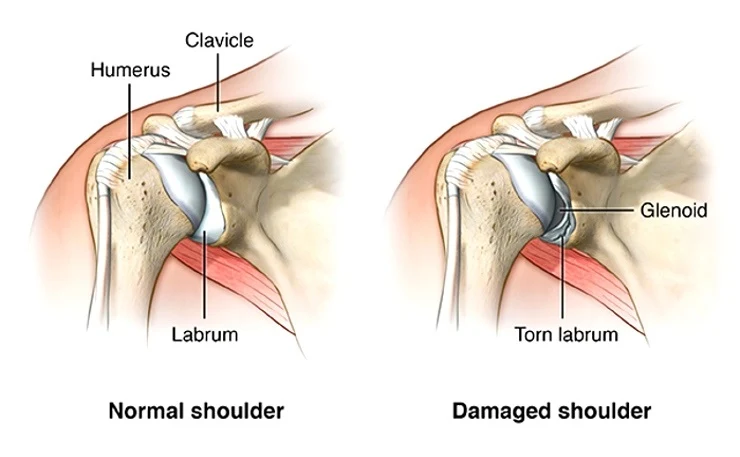Shoulder dislocation is a common injury in which the upper arm bone or humerus comes out of the shoulder blade socket. Learn more about dislocated shoulder symptoms, diagnosis, and treatment.
 |
| Normal shoulder vs Dislocated shoulder |
What is a Shoulder Dislocation? Symptoms and Treatments of Dislocated Shoulder
Shoulder dislocations are widespread among sportsmen in general, but notably among those who participate in sports such as hockey, football, skiing, and even gymnastics.
As a result, they are more common among teenage boys and young men. Dropping something, getting into a car accident, or having a seizure can all result in dislocation of the shoulder.
In this article, we will discuss “What is a Shoulder Dislocation, its Symptoms and treatments?
Shoulder dislocation symptoms include:
- During the occurrence, the individual may have experienced a popping or rolling sensation that caused them to lose their balance.
- The shoulder appears malformed - a lump or bulge may be apparent in the shoulder area, and the shoulders appear asymmetrical when viewed from the side.
- severe agony and discomfort, including excruciating ache while moving
- Numbness and numbness in the neck, hand, arm, and fingers are common.
- Muscle spasms may also be experienced by the individual.
- There is no movement or just restricted movement of the shoulder, although there is a great deal of pain.
Historically, the shoulder joint has been regarded as the most movable joint in the body. This joint is made up of a joint capsule and a ring of tendons, known as the rotator cuff, as well as a web of tendons, ligaments, and muscles that connect them all.
The shoulder joint may be dislocated as a result of the trauma force, especially if the force is applied in the forward direction. The severity of the impact, on the other hand, dictates the extent of the damage to the surrounding ligaments, muscles, and tendons.
If the damaged ligaments, muscles, and tendons are unable to be restored via a non-surgical strategy, then the shoulder dislocation will need to be treated medically to correct the problem.
Shoulder Dislocation Diagnosis and Treatment
Ensure that your patients recover completely and return to their sporting activities.
Recommend a treatment plan that will effectively restore the shoulder to its original position.
Look for signs of repetitive overhead movement, a history of past shoulder dislocation, and even hereditary factors that may be responsible for the shoulder dislocation before making a diagnosis. Shoulder instability develops as a result of repeated dislocations.
After assessing the issue, carry out a physical examination of the dislocated shoulder, as well as x-rays and other imaging tests, if necessary.
Surgical Treatment for Shoulder Dislocation
Initially, the treating orthopaedic surgeon will advise the patient to do the following:
- For immobilisation of the shoulder and arm, a sling should be worn for one to three weeks, and a range of motion exercises for the hand and wrist should be performed.
- Ice should be applied to the injured shoulder three to four times per day to help reduce pain and swelling.
- Intake of pain-relieving medications taken orally
- Therapy to improve shoulder function and movement while also strengthening the muscles surrounding the shoulder joint area is recommended.
Shoulder Dislocation Surgery Is Necessary in Some Cases –
In the event that the patient's condition does not improve or if the patient has shoulder instability, the surgeon will propose surgical therapies to repair the torn or stretched muscles and ligaments in the shoulder joint
The primary focus will be on repairing the shoulder joint and enabling them to correctly accommodate the joint. The following are the surgical options available for shoulder dislocation correction.
Bankart reconditioning
Bankart repair is used to treat anterior dislocations of the shoulder, which occur on the front side of the body and require surgical intervention.
The dislocation causes a tear in the labrum, which is the cartilage that surrounds the shoulder's socket; this tear is referred to as a Bankart lesion in medical terminology.
The surgeon will execute a Bankart repair, treat the torn cartilage, and reposition the damaged cartilage in the shoulder's socket to restore function.
The Latarjet technique
On a patient who has suffered bone loss in his or her dislocated shoulder socket, the Latarjet operation is performed. Repairing the frontal portion of the shoulder's socket will require the use of bone material from either the shoulder blade area or the iliac crest, as well as bone material from a donor (which is dangerous!).
Procedure for reimplissage
If the shoulder's ball needs to be repaired as a result of dislocation, the surgeon will propose a Remplissage procedure. A Hill-Sachs lesion is the medical term for this ailment.
The surgeon will work on the patient's head and resurface his or her skin. In addition, the surgeon will attach the ball of the shoulder to the rotator cuff.
Capsular repositioning
If the patient has a natural joint laxity condition, the surgeon will recommend that the patient undergo a capsular shift operation.
The purpose of this treatment is to tighten the ligaments that surround the shoulder, which has become loosened as a result of recurrent dislocations.
This procedure is also carried out on patients who have Ehlers Danlos Syndrome or who are at risk of developing shoulder instability issues.
The length of the recuperation period is mostly determined by the type of procedure conducted, which can be either open surgery or arthroscopic surgery. As part of his or her healing process, the patient will be required to participate in a rigorous physical therapy and rehabilitation regimen.


